2016 Ducati Multistrada 1200 Enduro First Ride Review
Now equally good on pavement or dirt
From the undeniable truth in the blanket statement “Motorcycles Don’t Suck,” one can journey down many a rabbit hole and come to many a contradictory conclusion, depending on what you want from your bike or where you happen to be riding. However, just as much as the answer to ‘Do Choppers Suck?’ tends to be a resounding “Yes!” for most situations, the answer to “Do Adventure Touring Bikes Suck?” almost always tends to be “No!” This is a fact more and more riders are learning first-hand as sales in the category continue to outperform the broader motorcycling landscape. And it’s no mystery why, really, as today’s adventure-touring formula relies on the strengths of several platforms to produce vehicles that can convincingly perform in every non-competition role for which a motorcycle can be used. There be bags, and performance, and comfort, and wind protection and maneuverability, and ground clearance, oh my!
2016 Ducati Multistrada 1200 Enduro
| Engine | 18.0/20 |
| Suspension/Handling | 12.5/15 |
| Transmission/Clutch | 8.0/10 |
| Brakes | 9.5/10 |
| Instruments/Controls | 5.0/5 |
| Ergonomics/Comfort | 9.0/10 |
| Appearance/Quality | 9.0/10 |
| Desirability | 9.0/10 |
| Value | 7.0/10 |
| Overall Score | 87/100 |
Ducati was ready to participate ahead of the market when it introduced the original Multistrada over a decade ago. Like most of its competition at that time, the original Multistrada was largely focused on strada and not intended to venture very far afield. It also made less than 100 hp and suffered from a lack of right-side cornering clearance thanks to a too-eager-to-grind exhaust shield.
Oh, how times have changed! The last few years have seen Ducati continue to focus on the strada while generously endowing each new generation with extra power and enhanced technology so that we now have long-legged superbikes with all-day comfort. Ducati’s competition spent the decade doing much the same, and also adding off-road prowess, a trick Ducati had pretty much shunned, until now.
Which brings us to beautiful Sardinia, a land of stunning vistas, serpentine roads, deliciously fresh cuisine, and a network of hidden trails woven through its foothills. Those trails are what really set this intro apart from previous Multistrada events… Ducati is finally going to let us get their big beauty dirty!
But first, let’s discuss what Ducati did and did not do in the process of adding the word “Enduro” to the Multistrada’s vocabulary.
Judging by its stance alone, it’s quite obvious the Multistrada Enduro it taking a new path. It is noticeably taller, with a lot more daylight visible below its frame and above its new spoked 19-inch front and 17-inch rear wheels, look a little closer and you see a new up-swept silencer that appears commendably trim and well tucked-in (thanks to a larger under-frame pre-chamber), a new twin-spar aluminum swingarm, longer fully adjustable fork and shock, a new very large fuel cell, a taller and wider handlebar, completely new bodywork including neat brushed-aluminum radiator shrouds, matching (optional) Touratech side cases are also made from brushed-aluminum, O-ring sealed, and mounted to a nice looking tubular aluminum Touratech rack.
Look even closer, and you start to see how serious Ducati is about transforming the Multistrada into an honest off-road tool. The foot controls are made from steel stampings so they can bend in a crash and be bent-back into shape without breaking, the rubber-topped pegs are actually open steel bear-trap style platforms that wouldn’t look out of place on a supercross bike once their removable rubber pads are jettisoned, and those spoked wheels feature some seriously beefy (tubeless) rims with their spokes mounting outside the tire beads. The list goes on. In total, Ducati claims to have changed 266 parts in the transformation to Enduro.
Same Heart, Different Soul
First and foremost, this is a modern Multistrada, unchanged at its core, so it uses the same frame, wonderful engine and comprehensive suite of electronics as the current 1200 S. That 158-hp Testastretta L-twin with DVT receives only a minor software tweak to its engine mapping, allowing it to offer more progressive throttle response from idle in an apparent attempt to make it just a tad more rider friendly when trying to tip-toe through the tulips off-road. Once the throttle is opened and the revs are up, its peak power and torque curves are identical to its more sportbike-oriented 1200 S sibling… no wonder Ducati claims this is the fastest off-road motorcycle in the world, faster even than their old factory Dakar rally bikes. It’s a lot of power for any motorcycle, let alone an “Enduro,” but its refined responses are simply a joy to experience. It makes for a really sweet engine, and after a day in the saddle, I think this is probably the best ECU mapping so far on a Ducati 1200; in fact, this exact map will be offered as an upgrade to existing Multistrada owners.
My only complaint is that the sweet baritone notes of its intake would sound even better if they were allowed to continue for another thousand rpm or two, and the rush would be that much sweeter if there were just a little more pull up top. Alas, Ducati rejected our request to build an Enduro fitted with a full Ducati Corse spec World Superbike motor. Have no fear, fearless reader, the stock Multistrada Enduro is still plenty sweet. Do yourself a favor and listen to the external shot of it lugging my behind up through the esses towards the camera at the opening of the video; that’s redline (three times) and that really ain’t a bad sound, at all.
The only physical changes to the powertrain are to the compact new up-swept “off-road style” silencer, its under-frame pre-chamber, and some different gear ratios including a slightly shorter first gear and three-tooth larger rear sprocket which help reduce speeds over the ground to 9.9 mph at 2,000 rpm in first gear, compared to the standard Multistrada’s first-gear speed of 12.4 mph at 2,000 rpm. That’s about 25% slower when crawling-around in the rocks, and it does make the bike seem more manageable and the engine more willing to comply when trying to maneuver at low speed.
If you are like me and you only use the clutch for starting and stopping on a motorcycle, I’ll need to point out something I’ve observed on all three Multistrada 1200s I’ve tested. There is a persistent false-neutral lurking between fourth and fifth gears unless you really give it some boot during the upshift. I tend to be very gentle with gearboxes, and big Ducati Twins generally respond well to my technique, but a quick breath on the throttle and gentle nudge from the left foot often wasn’t quite enough to fully engage fifth on the latest Multistradas.
For the eminently sane amongst us who can appreciate modern electronics, Ducati also saw fit to enhance the Multistrada’s Ride Modes, which offer select-on-the-fly switching through various named bundles of traction control, power modes, ABS and suspension settings. To make it easy, they named the bundles Sport, Touring, Urban and Enduro. I particularly enjoyed Sport and Enduro modes, the latter with DTC switched manually “Off.”
On our sunny serpentine high-traction road route, the “Touring” ride mode seemed excessively intrusive to me, with its low-rpm throttle response feeling notably flat, then making an almost abrupt transition into the upper-mid range. The Touring mode also automatically sets DTC to its highest level. That’s a ton of traction control, and though it may be good for really inexperienced riders or borderline icy conditions, it was clearly holding the Multistrada back at anything even approaching a sporting pace. Of course, the rider always has the option to deviate from the ride mode presets and can set the DTC, ABS, Power Mode, and Suspension settings independently to whichever levels they please.
Sport mode felt much more natural to me, and with the electronic suspension preload cranked up, the bike felt much more neutral and predictable, I wouldn’t say it’s nearly as tossable as a Turismo Veloce or Versys 650, but it is still more than willing to dance in the twisty bits. Sport mode also allows a lot more acceleration from the apex, making the electronics almost transparent at a mildly spirited clip.
Enduro mode defaults to a DTC setting of only level 2, which is quite a bit more liberal with the wheelspin compared to Touring mode’s level-5 DTC setting. It’s an impressive trick, that Enduro mode. It was nearly transparent out on the trail, allowing that giant sportbike engine and those big sportbike brakes to behave like proper dirtbike tackle, not too touchy yet not really holding the rider back much.
I really enjoyed the decreased brain tax afforded by the ABS during our often muddy off-road session, so after getting comfortable during the first leg of the dirt ride, I manually switched the traction control completely off and set engine response to medium. That gave me all 158 hp to play with whenever I wanted, but I still left the Suspension and ABS right where they defaulted from Enduro mode. Honestly, I found the extra throttle response and punch helped me turn the bike with less effort, which is no surprise, really, considering how top-heavy these big modern adventure bikes can all feel off-road.
Top-heaviness is a condition that calls attention to itself most when trying to maintain a tight line in muddy low-speed off-camber corners. That considerable weight often feels like it’s pushing the front tire to its limits, although deliberately breaking the rear tire loose with the traction control switched off often allows the bike to rotate without placing so much emphasis on its front contact patch. It also makes for cool crossed-up corner exits, which really are a lot of fun in a high-stakes sort of way. In other words, the rider can adapt to the weight, and most situations will allow alternative approaches to conquer the terrain.
Overall, I would say the Multistrada Enduro is perfectly capable of conquering just about any dirt road or modest trail, but it is really a bit too heavy and much too expensive to consider extreme conditions riding or serious air time. Sure it could be done, but one imagines that lovely new brushed aluminum bodywork will be just as fearsomely expensive to replace as any other Ducati bodywork. Fact: bikes fall-over in the dirt. Although I did manage to keep mine upright throughout the testing, a close-call while cross-rutted in a large mud hole had me worried enough about crash damage to dial it back a notch, even though I’m a journalist and probably wouldn’t have been billed. New owners beware.
Oh, Those Long Legs
The automatic damping adjustments provided by Ducati’s “Skyhook EVO” system have been fine-tuned to match the longer suspension components and the overall mission brief of the Multistrada Enduro. I found that when properly set for my weight and particularly aggressive riding style, the updated Skyhook software and the new longer forks and shock caused the Multistrada Enduro to ride near the upper-middle of its suspension stroke most of the time and all but eliminated the excessive fore/aft pitching and wallowy performance in G-outs that I complained about so much during last year’s Ultimate Sports Adventure Touring Shootout with a regular Multistrada 1200S.
The Enduro’s overall composure on-road seemed excellent to me at the medium-quick paces dictated by Ducati’s guide riders, and when we went off-road they continued to impress with a total lack of drama. Always plush and comfortable, the Enduro’s new suspension was damped enough in Sport mode when ridden semi-aggressively on dry pavement and then supple enough in Enduro mode to allow a good read of available traction off-road without wallowing anywhere, ever. I don’t think I’d change a thing.
In addition to a beefy new twin-sided aluminum swingarm and the aforementioned new longer forks and shock, Ducati also increased the offset of the triple clamps, which works in conjunction with the new fork’s 16mm of additional axle offset to net overall increases of 1 degree of rake, an extra 4mm of trail, and a front axle that is located fully 1.46 inches further forward compared to a standard Multistrada. Equally important, that new suspension nets the Enduro 1.2 inches of additional travel and ground clearance, those figures now totaling 7.9 inches and 8.0 inches, respectively.
The taller tire profiles and that 19-inch externally laced front rim also contribute to relaxing the geometry, as does the wheelbase which has grown a whopping 2.6 inches, now measuring 62.6 inches in total. This makes the bike more stable everywhere compared to a standard Multistrada, slows the steering noticeably, helps the bike slide more predictably off-road, and makes it desire constant pressure on the inside bar to hold the bike down through paved corners. Thankfully, Ducati also blessed the Enduro with an extra-wide set of bars that are 2 inches taller than a normal Multistrada, so even though the Enduro does take some additional input to keep turning or make quick transitions on-road, it really doesn’t require much extra muscle.
At Home in the Saddle
Ergonomically speaking, the bend of the Multistrada Enduro’s taller bar and the fact that its new mirror stalks angle forward at about a 45-degree angle to keep them out of the way of a standing rider’s forearms, both make the Enduro much easier to stand up on compared to a standard Multistrada. Although its humongous new 7.9-gallon fuel tank should offer in excess of 280 miles between fill-ups, it conspires with the Multistrada’s already fairly wide mid-section and the angular seams of the rest of the bodywork to cause the insides of a standing rider’s legs to make contact with something hard and angular on a regular basis… and erotic as that may sound, I can assure you it is less than pleasant.
The Multistrada Enduro does have the roomy cockpit one would expect from an adventure-touring platform, and its large tank, adjustable windscreen, cruise control, optional heated grips and optional Touratech aluminum luggage certainly make it an appealing proposition for finding new horizons.
Even though it is available with three different seat heights, stock and -20mm and +20mm options, just like the regular Multistrada, on the Enduro they all start from a higher elevation. The three options translate to heights of 33.5, 34.3, and 35.0 inches for the short, standard and tall seats respectively, so those who feel a burning need to have both feet flat on the ground at every stop should probably look elsewhere or figure out how to ride bikes with seat heights taller than their inseams. Our test bikes had the standard middle-height seats which seemed to result in just slightly cramped knees for this journalist, just like on a regular Multistrada. To be fair, that legroom seems to have become my own personal grudge thanks to old Army and roadracing injuries, not to mention a general lack of fitness which is currently weighing me down to the tune of an extra metric ton or so. Unfortunately, Ducati didn’t have any tall accessory seats at the intro, so I cannot confirm if that would eliminate my one ergonomic gripe, although the extra 20mm of seat-to-peg distance certainly wouldn’t hurt.
In conclusion, I found the new Multistrada Enduro to behave a little better for my riding style than a standard Multistrada. It performs great on the road (if you don’t mind the slower steering and muscling around the extra stability), very respectably off-road, and offers enough comfort to seriously consider its potential for multi-day explorations. If you dig the sound and the looks like I do, and if you can afford the fairly steep $21,295 cost of entry, then a new Multistrada Enduro deserves serious consideration as your next sport/adventure-touring machine.
2016 Ducati Multistrada 1200 Enduro
+ Highs
- Comfortable and fun on-road
- Powerful and capable off-road
- Sounds like a Ducati Superbike
– Sighs
- Tall seat height doesn’t result in much extra legroom
- Relaxed geometry compromises some on-road nimbleness
- Crash repair costs not well suited to use as a dirtbike
2016 Ducati Multistrada 1200 Enduro Specifications | ||
|---|---|---|
| MSRP | Starting from $21,295 | |
| Colors | Phantom Gray, Star White Silk, or Ducati Red | |
| Engine | Testastretta with variable valve timing, L-Twin cylinder, 4 valve per cylinder, Dual Spark, Desmodromic, liquid cooled | |
| Displacement | 1198.4cc | |
| Bore x Stroke | 106 x 67.9mm | |
| Compression Ratio | 12.5:1 | |
| Power | 158 hp (117.7 kW) @ 9,500 rpm | |
| Torque | 100.3 lb-ft (136 Nm) @ 7,500 rpm | |
| Transmission | 6 speed | |
| Primary Drive | Straight cut gears, Ratio 1.84:1 | |
| Gear Ratios | 1=37/15 2=30/17 3=27/20 4=24/22 5=23/24 6=22/25 | |
| Final Drive | Chain; Front sprocket 15; Rear sprocket 43 | |
| Clutch | Light action, wet, multiplate clutch with hydraulic control. Self-servo action on drive, slipper action on over-run | |
| Frame | Tubular steel Trellis frame | |
| Front suspension | Sachs 48mm fully adjustable usd forks. Electronic compression and rebound damping adjustment with Ducati Skyhook Suspension (DSS) | |
| Front wheel | Tubeless spoked wheel in light alloy 3″ x 19″ | |
| Front Tire | Pirelli Scorpion Trail II 120/70-ZR19 as optional Pirelli Scorpion Rally same measure | |
| Rear Suspension | Fully adjustable Sachs unit. Electronic compression & rebound damping adjustment. Electronic spring pre-load adjustment with Ducati Skyhook Suspension (DSS). Aluminum double-sided swingarm | |
| Rear Wheel | Tubeless spoked wheel in light alloy 4.50″ x 17″ | |
| Rear Tire | Pirelli Scorpion Trail II 170/60-ZR17 as optional Pirelli Scorpion Rally same measure | |
| Front Wheel Travel | 7.9 in (200mm) | |
| Rear Wheel Travel | 7.9 in (200mm) | |
| Front Brake | 2 x 320mm semi-floating discs, radially mounted monobloc Brembo calipers, 4-piston, 2-pad, with cornering ABS as standard equipment | |
| Rear Brake | 265mm disc, 2-piston floating caliper, with cornering ABS as standard equipment | |
| Instrumentation | Color TFT display 5″ | |
| Dry weight | 496 lb (225 kg) | |
| Wet weight (curb) | 566 lb (257 kg) | |
| Seat Height | Non-adjustable35 in (890mm). (34.25 – 33.5 in (870 – 850mm) with low seat) | |
| Wheelbase | 62.76 in (1594mm) | |
| Rake | 25.0° | |
| Trail | 4.3 in (110mm) | |
| Fuel Tank Capacity | 7.9 US gal (30 l) | |
| Standard Equipment | Riding Modes, Power Modes, Cruise control, ABS cornering, DTC and DWC, RbW, Hands-Free, Full LED headlamp with light cornering function, Bluetooth module for infotainment | |
| Warranty | 24 months unlimited mileage | |
| Maintenance Service Intervals | 9,000 mi (15,000 km) / 12 months | |
| Valve Clearance Check | 18,000m (30,000 km) | |
| Emissions Standard | Euro 4 | |
| Fuel Consumption | 41.6 mpg (5.66 l/100 km) | |



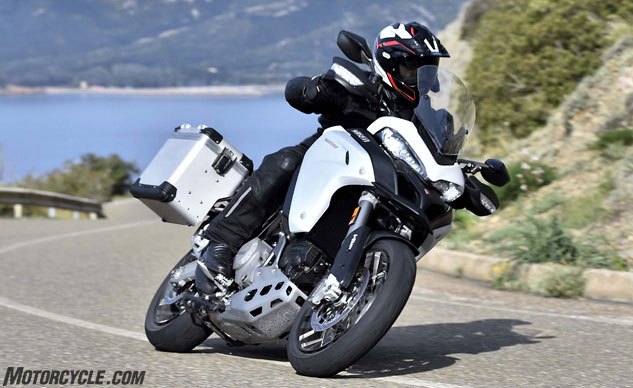
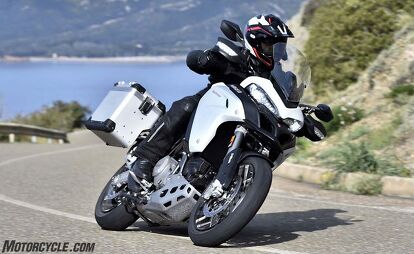








































































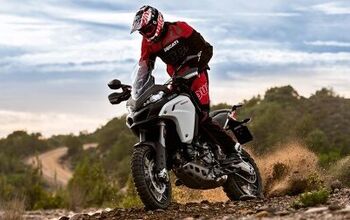
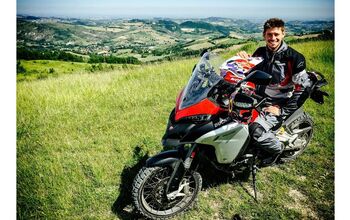
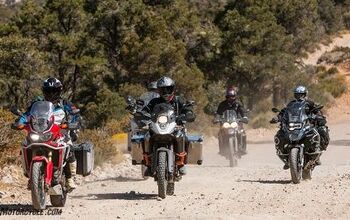

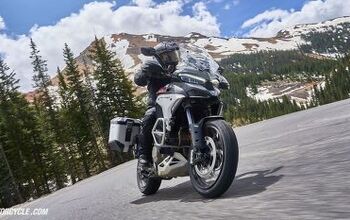












Comments
Join the conversation
I've got the '15 multi and have been on a lot of fire and 'seasonal use' dirt roads... it does fine there but when things get rutted and rough you definitely feel its weight, limited travel and road oriented tires. There's no fix for the weight of these large ADV bikes (which for me makes them unsuitable for true offroad use) but clearly the new enduro multi addresses the other shortcomings of the strada oriented multi - it looks like a fine competitor for the other heavyweights in the market.
It's all nice,but what I Thicke we all want to know is,how do you feel it compares (first impressions)to the Ktm SA and Bmw Gsa,On and off-road?